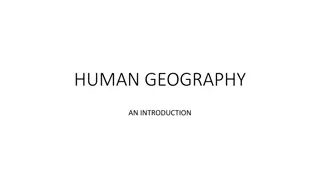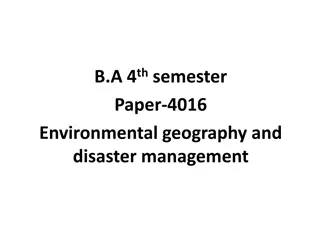Understanding Key Concepts in Economic Geography
Economic Geography is a sub-discipline that utilizes a geographical approach to analyze the spatial distribution of economic activities at various scales. It focuses on the location of economic activities and their relationship with the environment, encompassing primary, secondary, and tertiary sectors. Economists differ from economic geographers in their viewpoints on the role of geography in understanding economic processes. The discipline also explores the concept of relative location and centrality in global trade. Key theoretical perspectives and major concepts are studied through different approaches in Economic Geography.
Uploaded on Jul 20, 2024 | 1 Views
Download Presentation

Please find below an Image/Link to download the presentation.
The content on the website is provided AS IS for your information and personal use only. It may not be sold, licensed, or shared on other websites without obtaining consent from the author. Download presentation by click this link. If you encounter any issues during the download, it is possible that the publisher has removed the file from their server.
E N D
Presentation Transcript
ECONOMIC GEOGRAPHY ECONOMIC GEOGRAPHY SEM VIII TOPIC 1: KEY CONCEPTS & APPROACHES OF ECONOMIC GEO COURSE INSTRUCTOR: NAUSHEEN MAZHAR
OUTLINE: Economic Geography Approaches to study Economic geography Relationship with other branches of geo Scope Key concepts Major theoretical perspectives
SOURCE BOOKS: Coe, N.M., P.F. Kelly and H.W.C. Yeung, Economic Geography: A Contemporary Introduction. (Oxford: Blackwell, 2007) [ISBN 9781405132190]. Economic Geography, 3rdEdition, Truman A. Hartshorn, John W. Alexander
ECONOMIC GEOGRAPHY IS A SUB-DISCIPLINE THAT USES A GEOGRAPHICAL APPROACH TO STUDY THE ECONOMY.
DEFINITION: The study of spatial distribution of man s economic activities, primary, secondary & tertiary, with relation to his environment. It refers to the field of study focused on the location of economic activityat the local, national and world scale (Hartshorn and Alexander, 2007) Dudley Stamp: Eco geo involves consideration of the geographical and other factors which influence man s productivity, but only in limited depth, so far as they are connected with production and trade
KEY DIFFERENCES BETWEEN ECONOMIC GEOGRAPHY KEY DIFFERENCES BETWEEN ECONOMIC GEOGRAPHY AND ECONOMICS APPROACHES AND ECONOMICS APPROACHES Economists usually pay little attention to the geographical dimensions of economic processes Economic geographers consider geography as being essential for the understanding of the ways economies work. -different views of the economy -the way it operates Economists see the economy as a machine that works according to certain principles and whose behaviour can be predicted using modelling techniques. Mathematics is therefore the main language economists speak .
IT CONTINUES WITH RELATIVE LOCATION Peripheral or central location? Accessibility? Major world trade lanes Mongolia rather inaccessible Western Europe -- centrality 7 Australia (not seen) peripheral
SCOPE It provides acquaintance with, A) The natural conditions and natural resources of a country as a whole, and each of its large regions taken separately B) various aspects of man himself-distribution, density and age C) Culture, technology, capital etc.
TASK Search the web and come up with 2 points each about the significance of economic geo
METHODOLOGY OF STUDY: Three approaches suggested to study economic geo: 1. Traditional approach 2. Philosophic approach 3. Modern approach
ACTIVITY TIME! Divide the class in 3 groups and take a single approach for your group Discuss the material from your handouts and make notes to present
KEY CONCEPTS OF ECONOMIC GEOGRAPHY: SPACE, PLACE AND SCALE KEY CONCEPTS OF ECONOMIC GEOGRAPHY: SPACE, PLACE AND SCALE 1. Space: The concept of space refers to physical distance and area. The concept of space allows us to ask simple questions such as where a particular process is happening. Four interrelated elements of the concept of space can be identified: a) territoriality and form (e.g. a territorial form of a particular country) b) location (e.g. a location of a particular country) c) flows across space (e.g. trade flows between countries) d) the concept of uneven space as a necessary condition of a capitalist system
2. PLACE: The concept of place aims to capture the specificity or uniqueness of particular places that are carved out of space. Through this geographers are able to explore the richness and complexity of particular places and economic processes which are always embedded in environmental, social, cultural, institutional and political contexts. The idea of being embedded is very important because environmental, social, cultural, institutional and political contexts influence (and, in turn, are influenced by) economic processes. Many Western (occidental) values, for instance, may be alien to many other cultures, societies or nations. Therefore, the way economies are constructed and performed may be very different in different places (e.g. in London or in Trinidad).
3. SCALE The concept of scale therefore helps us to organise places through a typology of spatial scales. Spatial scales that are commonly used by economic geographers include: a) global scale b) macro-regional scale (e.g. South-East Asia, Europe or North America) c) national scale (e.g. USA, UK, France, Niger, Japan) d) regional scale (e.g. California or South East of England) e) local scale (e.g. Silicon Valley, Manhattan or the City of London) f) lived places (e.g. workplaces and homeplaces)
MAJOR THEORETICAL PERSPECTIVES Neo-classical location theory: Location theory flourished in the 1950s and the 1960s Primarily interested in establishing and explaining patterns in the distribution of economic activities across space. Firmly anchored in a neoclassical economics theory and used a model-based approach to study the location of economic activities (e.g. firms) in space. This period often called a quantitative revolution
BEHAVIORAL APPROACH: This approach emerged in the late 1960s as one of the reactions to the quantitative revolution . It explored a wider range of factors that influence economic decision making of human actors in various situations. The problem with this approach, however, is that it fails to explore fully the relationships between individuals and society.
STRUCTURALIST APPROACH/MARXIST POLITICAL ECONOMY By contrast, a Marxist political economy approach, places social relations at the centre of its analysis, with an emphasis on class. Since the 1970s Marxist views started to influence geography and still have a significant influence on economic geography today. Importantly, Marxist-inspired economic geography moved the attention from spatial patterns and locational issues to questions of social relations and economic structures of capitalist economies.
POST-STRUCTURALIST APPROACHES/NEW ECONOMIC GEOGRAPHY: Since the mid-1990s, a new type of economic geography has started to emerge from post-structuralist ideas. New economic geography insists that economic process cannot be seen in isolation from social, cultural and political contexts. It argues that social, cultural and/or institutional factors are central to the functioning of the economy/economies.























